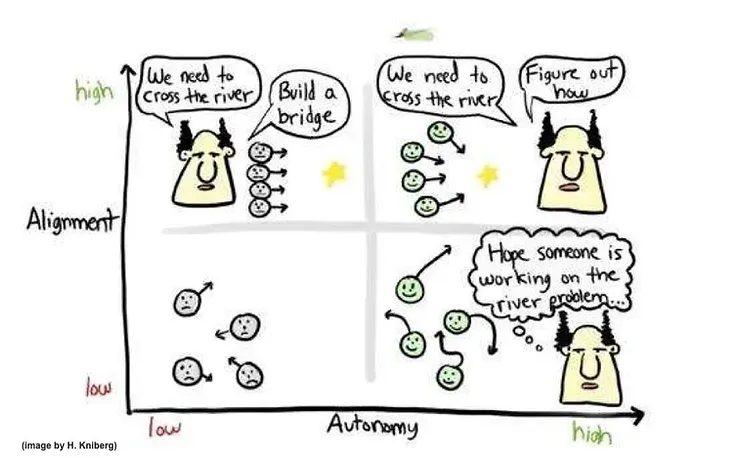A story about leadership
“If you want to build a ship, don’t drum up people to collect wood and don’t assign them tasks and work, but rather teach them to long for the endless immensity of the sea.” - Antoine de Saint Exupéry
Alignment is the state of people going in the same direction.
By definition, a company is a group of people coming together to solve a problem that they wouldn’t be able to by themselves. Usually started by a small group of visionaries, the need for alignment techniques does not exist, everyone knows what they are in for. As the company grows, the reason for being naturally weakens and, if left unaddressed, it may eventually disappear.
To try to slow down or stop this process, an organization will usually try to reach alignment, aiming to have every employee heading in the same direction. There are many ways to do so. It varies per company, depending on their size and culture. In multiple organizations though, it takes the form of 4 artifacts: The mission, the vision, the strategy and the culture.
- The problem solved for the customers is called the company mission. The mission is permanent. (Example from Google’s: “to organize the world’s information and make it universally accessible and useful.”)
- The state it wants to reach on the mission is called the company vision. The vision timespan is 5-10 years, sometimes up to 50 years. (Example from Google’s: “to provide access to the world’s information in one click.”)
- The next building block on that vision is called the company strategy. The strategy points out what next steps are to be taken towards the vision. The strategy timespan is 3-5 years but depending on its maturity it can be even 1 year. (Ex: part of a strategy could be “Build brand recognition in South America”)
- The culture is defined by a set of values/principles that is expected to be shared by every employee, guiding the decisions made. (Example from Smartly’s: “Humble, hungry, hunter”, which means “Being ambitious and going for your goals, hungry to learn and do more, but still staying humble while doing so”)
In my 13 years on the job market, I have seen a few examples of Small(<50 employees), Medium (<250 employees) and Large entreprises (nothing past a 1000 employees yet). In the following chapters, I will talk about alignment methods and environments I have first hand experience in.
This is my experience of the situations, others might have felt it was completely different for them.
Drifting
Situation: No mission, no vision, no clear leadership, no strategy
The requests of your customers are the only source of work done on your software product.
Successes:
The customers are content because they are getting exactly what they ask for. In that sense, it ressembles the movie “Yes man”, where the main character has to say yes every time a proposal is made to them.
In the short term, this kinda works, everyone is happy.
Difficulties:
Imagine piloting a boat but someone else control the rudder with their own destinations in mind. Now multiply that one person by multiple pulling in their own directions. You end up with a product that is like a Frankenstein’s monster, stitched together from various customer-specific parts, lacking a cohesive and unified design. Furthermore, over time, your costs rise because you need to maintain all these custom parts, and you don’t ever reach the scaling advantages of building products (Distribution of development costs across the customer base, efficient development, deployment and maintenance, standard practices, …)
Another issue is that, unless your customers have the exact same needs as your market, you are not going to be able to grow your business. This is for the simple reason that your potential customers will have needs that you cannot spend resources on (The current customers tell you what to do), and, unless they themselves are ready to cash in for custom developments, these needs are never going to be met.
In many cases, what your customer wants is not what they need. This is same reason why, when you do proper interviews in research, you have to focus on the customers ways of working, their problems, what they did in the past, to find solution to their needs rather than what they want you to build.
Finally, the customers do not know what is feasible, what is simple and hard to do. This often results in a challenging situation when trying to explain to a customer that something they think is easy is, in fact, an extremely hard endeavor.
Possible ways to improve:
If someone is studying or knows the market status, showing the owners the expectations of the market with data and building a business case may help in getting an R&D function funded.
The customers, in this situation, are very comfortable, they get whatever they desire. Changing that situation is possible I think, but requires challenging their own reasoning. It may be possible to do by building some trust and coming to them with data proving why focusing on their needs rather than their requests is going to help them. If you attempt that change, make sure that your management has your back, or you might quickly find yourself on an ejectable seat. As is typical when trying to persuade someone, you need to clearly communicate what’s in it for them.
Employee experience:
“I wish we had a product”
In the next post: A single manager takes control of the rudder to guide the company. —

